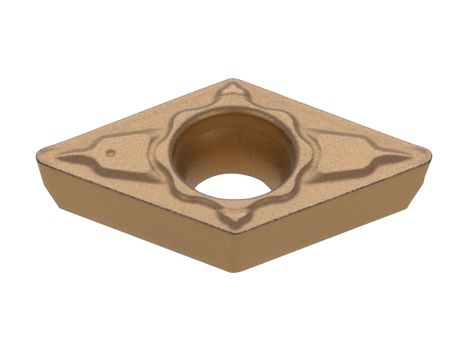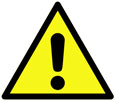55° Carbide Insert
While not inexpensive, carbide inserts offer excellent value—each insert provides four cutting edges, significantly reducing the need for frequent sharpening and saving valuable time.
Carbide cutters perform well on hard-to-machine materials like cold-rolled steel and are also effective on aluminum, brass, and leaded steels, offering exceptional durability. However, for the finest finishes on softer metals, a well-sharpened high-speed steel tool still delivers superior results.
This is the 10-pack of replacement carbide inserts for the following tool holders:
- Straight Insert Tool Holder
- 55° Carbide Tool Holders
- 55° RH Boring Bar
- 55° LH Boring Bar
- 55° RH 3/8″ Boring Bar w/2 Flats
- 55° LH 3/8″ Boring Bar w/2 Flats
- Quick-Change Carbide Insert Tool Holder
-
| INSCRIBED CIRCLE | 0.250″ (6.35 MM) |
| CUTTING EDGE LENGTH | 0.254″ (6.45 MM) |
| INSERT THICKNESS | 0.094″ (2.38 MM) |
| CLEARANCE ANGLE MAJOR | 11° |
| INCLUDED ANGLE | 55° |
| ISO INSERT DESIGNATION | DPMT 21.51 |
| CORNER RADIUS | 0.016″ (0.4 MM) |
| MINIMUM FEED PER REVOLUTION | 0.002″ (0.05 MM) |
| MAXIMUM FEED PER REVOLUTION | 0.006″ (0.16 MM) |
| DEPTH OF CUT MINIMUM | 0.004″ (0.1 MM) |
| MAX DEPTH OF CUT | 0.059″ (1.5 MM) |
Related products
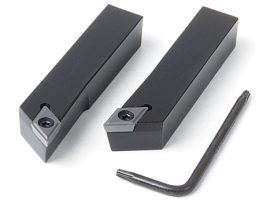

55° RH and LH Tool Holders w/Carbide Inserts
These tool holders are available individually in right-hand or left-hand configurations, or as a matched pair. Each holder includes a 55° carbide insert, a hold-down screw, and a Torx® key for installation. Designed with a 3/8" square shank, they fit standard 3/8" tool posts, and the insert tip is precisely 0.375" from the base of the holder—an industry-standard dimension.
The 5° offset angle of the cutting tip provides added versatility for certain operations. For example, when the holder is squared with the crosslide, it allows you to turn an outside diameter (O.D.) up to a shoulder and then finish the shoulder by backing the tool out—while maintaining proper tool clearance.
Constructed from case-hardened steel with a durable black oxide finish, these holders are built for long-lasting performance.
Although carbide insert tools are more costly than high-speed steel (HSS) tools, they offer an advantage: when the cutting edge becomes dull or chipped, you can simply rotate the insert 180° to use the second edge—essentially giving you two tools in one.
While HSS tools remain the primary choice for miniature machining due to their low cost, resharpenability, and adaptability for custom form tools, carbide insert tools are invaluable for specific applications. They maintain a sharp edge when cutting hard or abrasive materials, reduce tool wear, and allow for faster machining—reasons why they're widely used in professional machine shops.
Note: Tool orientation is named by the direction the chip exits the tool. A right-hand tool has its cutting edge on the left, and the chip peels off to the right.
Updated Note: The previously used straight-groove chip breaker insert shown in some images is no longer available. All current inserts now come with the spider web-style chip breaker as shown here.
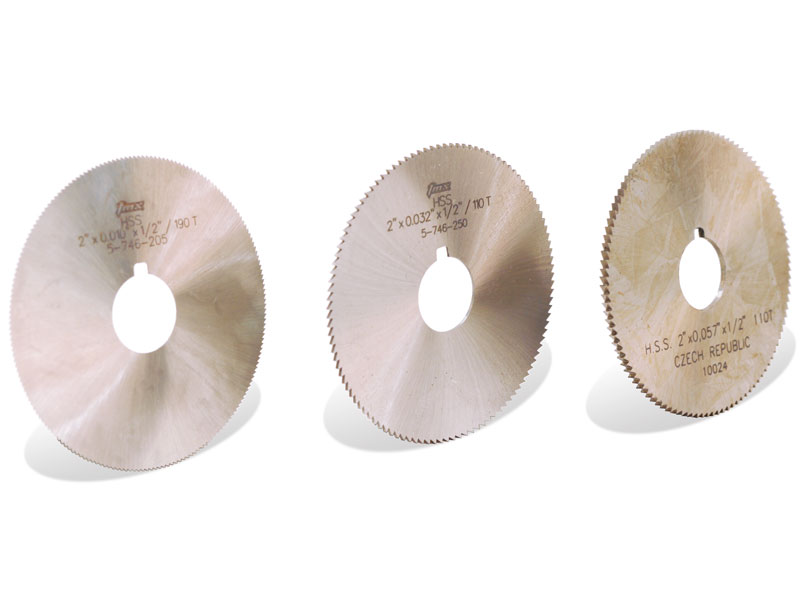

Slitting Saws
Each saw blade is 2" in diameter with a 1/2" hole. The saw blades come in varying thicknesses and teeth counts. They require the slitting saw holder, which is held in the spindle with a drawbolt that pulls the holder up into the Morse #1 taper.
Note: Due to supply chain issues, the outside diameter of some of our saw blades may be 2-1/2" instead of 2" and teeth counts can vary. If you need a specific number of teeth in a certain size, please contact us to see if we have them in stock
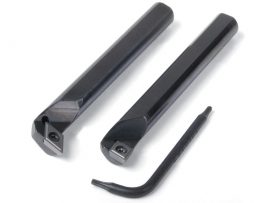

RH 55° and 80° 3/8″ Boring Bars w/Carbide Inserts
These 3/8" diameter boring bars feature a carbide insert secured with a Torx® screw and come complete with a Torx wrench. Choose between:
-
A 55° right-hand insert, suitable for starting holes as small as 3/4", ideal for reaching sharp internal corners
-
An 80° insert, which fits into a smaller 1/2" hole and offers added strength for roughing operations
Each holder measures 3-1/4" long and can bore to a depth of just over 2" when properly secured with two set screws. Manufactured from durable 1144 Stressproof® steel with a black oxide finish, these tools are available individually or as a discounted set.
Why Choose Carbide Insert Tools?
While high-speed steel (HSS) remains common for small machine tools due to its low cost and resharpenability, carbide inserts offer significant advantages in demanding applications:
-
Longer-lasting edges when cutting hard metals like stainless steel, titanium, or abrasive materials such as carbon fiber
-
Faster cutting speeds and greater efficiency
-
Each insert can be rotated 180°, effectively giving you two cutting edges per insert
Although carbide inserts can't be resharpened, their durability and versatility make them a preferred choice in professional machine shops.
Note: The older straight-groove chip breaker insert is no longer available. Current inserts include the spider web-style chip breaker, as shown in the updated images here & here
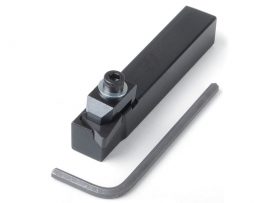

Ceramic Insert Tool Holder
Designed for cutting hard materials like tool steel, this ceramic insert tool holder features a triangular insert mounted at a negative rake angle. The downward tilt of the insert provides proper side clearance, allowing you to use all six cutting edges—three per side—before needing a replacement. The 3/8" shank fits Sherline’s P/N 7600 tool post (not included). A clamp, hold-down screw, and 3/32" hex key are included for secure installation. Replacement inserts are available as (P/N 22659).
Why Use Ceramic Inserts?
Ceramic cutting tools are a powerful addition to the modern machinist’s toolbox. Though more brittle than high-speed steel (HSS) or carbide, ceramic inserts excel at cutting hardened steels and other tough materials, especially at higher spindle speeds. This makes them ideal for jobs that would otherwise be extremely difficult or impossible—such as turning down the shank of an end mill.
This insert’s large nose radius helps achieve an excellent surface finish, particularly when profiling.
-
Each insert offers six usable cutting edges:
-
Rotate 120° to access a new edge (3 per side), then
-
Flip the insert for 3 more cutting points on the opposite face
-
-
In comparison, traditional carbide inserts offer only 2–4 cutting edges, making ceramic inserts cost-effective over time, despite the higher upfront cost.
Usage Notes & Safety Information
-
Ceramic inserts are brittle and should be used with proper technique to avoid chipping or breakage.
-
Caution: Chips produced during cutting can be extremely hot—even red-hot. Use protective eyewear, gloves, and fire-safe clothing when operating.
-
Some materials, such as tool steel, may form long, stringy chips that wrap around the part ("bird’s nest" effect).
Use a chip brush and stop the machine frequently to clear chips. These chip clusters can ignite if they come in contact with hot chips.
